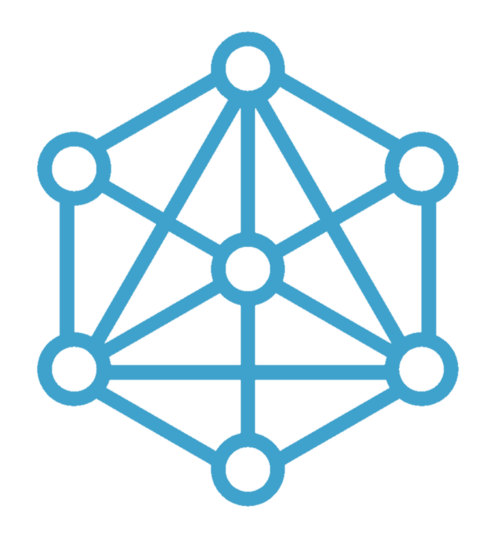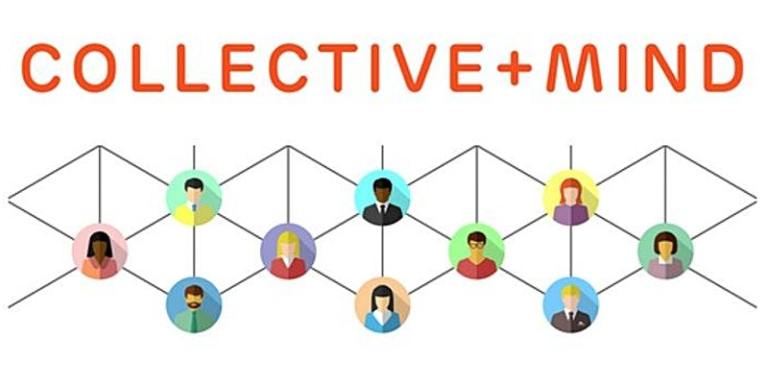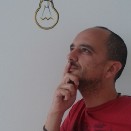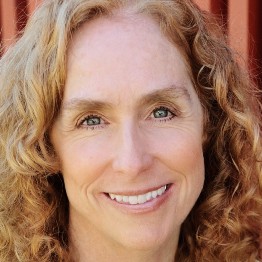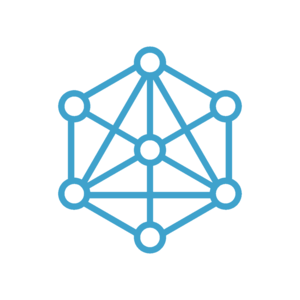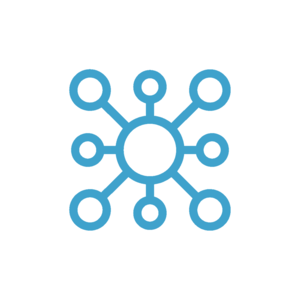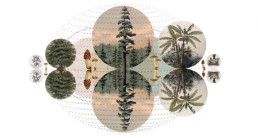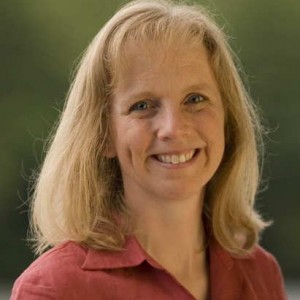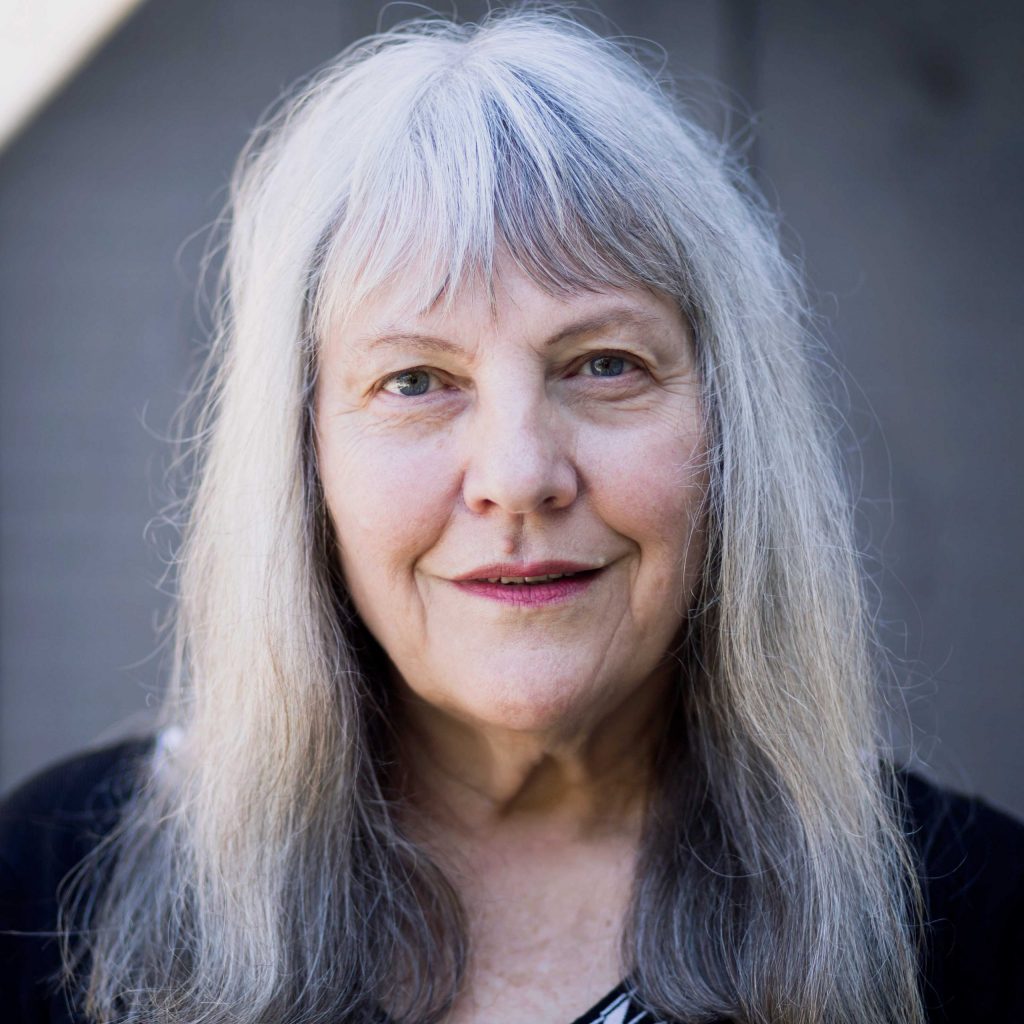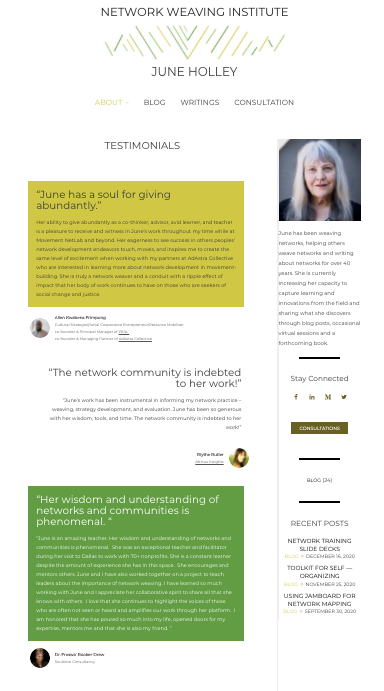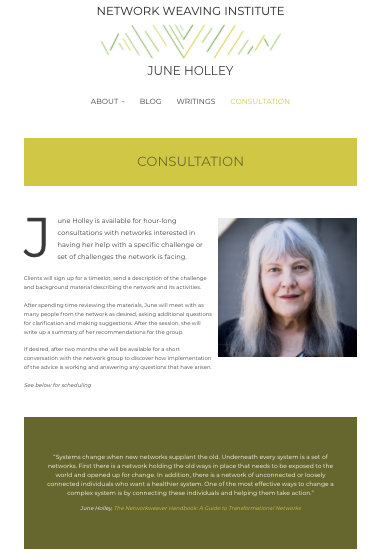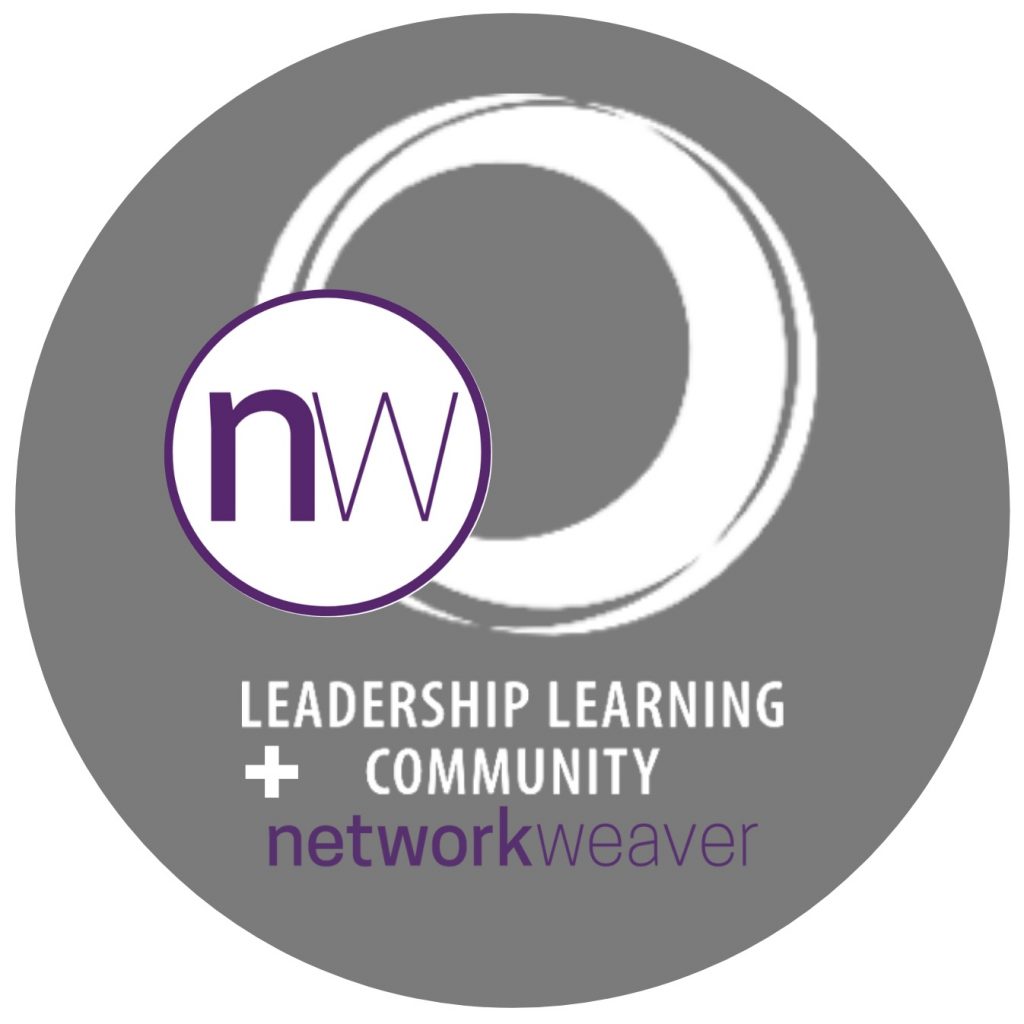Organizing models for social change: Networks as an inclusive category
Creating social change of any sort requires organizing the people who have an interest in the issue or problem at hand. The global social impact space has a wide range of terms — networks, movements, alliances, consortiums, coalitions, communities, partnerships, forums, initiatives, campaigns, and more — for how people and groups are organized across geographies and topics to affect change. While the titles represent some variations in approach, orientation, and composition, these types of organizing models share a lot in common.
What should we understand about organizing models?
A quick search of definitions highlights the important differences and nuances of various types of organizing models. [1]
- Coalition — a temporary alliance of distinct parties for joint action.
- Consortium — a group formed to undertake an enterprise beyond the resources of any one member.
- Alliance — a formal agreement or association to further the common interests of members by merging efforts.
- Partnership — a formal relationship involving close cooperation between parties with specified and joint rights and responsibilities.
- Movement — a diffusely organized or heterogeneous group of people or organizations tending toward or favoring a generalized common goal.
What all of these models have in common is that they are about connecting and facilitating interactions between people or organizations to take action together. They convene groups around a shared purpose and merge efforts and resources towards collaborative action.
Organizing models also typically define who is involved, why, and how they plan to achieve their goals.
· Who — the people or organizations that have an interest in the issue or problem at hand and that are coming together.
· Why — the common interests amongst participants and the shared goals they seek to achieve together.
· How — the ways in which the participants are connecting, interacting, merging efforts, and undertaking collective action to achieve their shared goals.
Networks as an inclusive category of organizing models
At Collective Mind, we use the term “networks” to encompass this expansive range of organizing models and their common components.
Networks can come in all shapes and sizes. They can range from the informal — for example, a group of professionals with a shared interest in reducing inequality in their field who communicate via a Slack channel — to the highly formalized, such as a global network with organizational members in each country who formally apply for membership or an alliance of European NGOs formed on the basis of a legal arrangement for sharing funds and achieving shared goals. The category of network can include a pan-African movement organized through national associations and local community groups, all of whom participate in achieving a shared vision, as well as the hybrid setup of a US-based nonprofit that runs its own programs while also coordinating a network.
Whatever their labels, these networks seek to collectively and participatorily achieve goals that none of the participants can achieve by themselves. At their core, they integrate participants who have common interests and work together to achieve shared goals. That is where the power of networks lies.
[1] Definitions taken from Merriam-Webster, Cambridge Dictionary, and Dictionary.com
Originally Published at Collective Mind
Featured image by Kubko
Collective Mind seeks to build the efficiency, effectiveness, and impact of networks and the people who work for and with them. We believe that the way to solve the world’s most complex problems is through collective action – and that networks, in the ways that they organize people and organizations around a shared purpose, are the fit-for-purpose organizational model to harness resources, views, strengths, and assets to achieve that shared purpose.

The Square, the Tower, and the Circle:
The Blind Spot in the Stewardship of Locally Led Systems Change Networks
The Plight of the Social Activist
Many social activists can relate to the following scenario. They sign up for an intensive training in a beautiful nearby region, with the intention of networking with fellow activists and learning about social change and innovation. The timing is perfect — they feel like they’ve been working alone for years and are struggling to see the impact of their efforts. They sense that what they’ve been doing has a significant impact on the people they touch, but at the same time they feel like a mere drop in the ocean.
They keep seeing the same patterns of behavior and destruction around them, regardless of the enormous amount of energy and creativity they’ve put into their work. The problem just seems too big and intractable.
They think they’ve found the perfect training — one in which they’ll learn about systems thinking and how the tiny efforts of a small group of committed individuals can add up to create massive, exponential change. Linking is a central idea, and the concepts of ‘network’ and ‘network weaving’ are thrown at them throughout the training. They learn about complex systems, emergence, tipping points, and the viral spread of ideas, all while participating in discussions and creative dialogue sessions where a deeper understanding of their peers’ interests and struggles is achieved. They partake in fascinating group dynamics and games meant to challenge certain mental models and an unsustainable amount of post-it notes are consumed in an effort to define goals. As a group, they go through the usual stages of development: forming, storming, norming, performing and adjourning before waving goodbye to their colleagues and facilitators.
In the time following the training, the group stays in touch — those who live close to each other organize meetings and casual get-togethers, while others join via zoom. Some of the participants even go as far as successfully planning activities together. However, others begin opting out as the pace of life returns and the retreat effect starts wearing off. It’s hard to meet given everyone’s schedules and other issues arise such as internet connectivity and disagreements on the preferred communication platform.
It’s not long before everyone reverts to the same routine of hunting for the next funding opportunity in order to put food on their tables. The training becomes a fond memory for the activist. They keep in touch with the new friends they’ve made, but the vision of a strong coalition to bring about big systematic change now seems very distant. New relationships were formed and a network was weaved, but they feel that they’re back where they started, focusing on their own work and wondering whether their small efforts will indeed produce any meaningful change amidst the powerful status-quo.
Disrupting the Pattern
If you can relate to this story, you’re not alone. Many activists, change makers, social innovators and civil society leaders have gone through this experience. It is a pattern.
What is the blindspot of social networks? The governance in the networks that fuel social change movements. Despite the recent interest in the shift towards networked strategies for social change, there is still a lot to be explored concerning the questions surrounding decision making and the establishment of network policies together with its collective mission.
A deep and structured conversation about network governance is required and needs to be included in the design process of network initiation. It is an integral part of the responsibility of NGOs who convene networks and should be held and carried out by the funder and donor community worldwide.
Systems Change Networks and Their Governance
In one way or the other, most social movements are a form of challenge to established powers. That power can take the form of an oppressive regime, an unfair economic system, or corrupt systemic status quo. The latter is the most difficult to tackle since it does not have a simple hub and spoke structure that can be understood and dismantled piece by piece. Examples of systemic status quo are racism, environmental violence, or protracted civil conflict.
This article addresses the struggles related to shifting systems, particularly the ones that have no linchpin or clear leverage points: no regime to topple, no significant companies to sue, and no peace treaty to negotiate. There may be no clear endgame or road towards it and no clear definition of success or failure, other than a sensible change of the current status quo.
These are the most difficult struggles to pursue for social movements and the networks fueling them as they entail a bitter provocation to the network members. They may be asking themselves:
“Is the way we self-organize to change the status quo not a mere reflection of the status quo itself? Aren’t we simply replicating old patterns of working and “fighting” that contain within themselves the seeds that created the current status quo in the first place?”
If taken in earnest, this provocation gives rise to a tension that many social change movements face and fail to overcome. The movement needs to become agile and organized enough to plan and coordinate many different small scale actions across the spectrum of the complex field they are operating in. A network strategy is said to be adopted: instead of a few large scale actions coordinated by a central committee, many diverse and synchronized small scale initiatives are planned. These initiatives are not organized or mandated centrally. Still, they are attuned to a set of shared, high level, mission statements and principles, leaving the details of their execution to the local change agents.
Yet, this mere synchronization requires a form of governance and hierarchy. There are decisions to be made, actions to be taken, people to speak to, and money to spend. But the typical form of governance where a leader is elected by majority vote leads to a network topology that is not suitable for dealing with complex problems. This approach tends to degenerate from the concentration of power and authority held by a few individuals in the network, which is exactly what social movements wanted to avoid in the first place.
The Square and The Tower
In the 2018 book The Square and the Tower: Networks, Hierarchies and the Struggle for Global Power, author Niall Ferguson takes the reader through history’s defining moments by putting in perspective the role that individuals and social networks played in them. The book uses the metaphors of “the square” to symbolize the place where informal, loosely structured social networks end up convening, and “the tower” to represent the formal top-down hierarchical power. The author challenges the somewhat romantic idea that networks or movements spun with the help of modern communications technologies have the ability to replace traditional systems of governance. Although Ferguson’s analysis sounds about right, it is missing the contribution of another geometric shape: the circle.
Governance is a heavily loaded word. It brings about associations with concepts such as government, bureaucracy and power over people. Yet, every system, be it natural, artificial, social, biological or mechanical, needs a form of self-regulation. We call this process of self-regulation “governance”. It is a process by which the system senses the outside environment and adapts its actions in order to fulfill its purpose accordingly.
How to achieve this process of self-regulation while balancing the tension between collective purpose and individual freedom is the value proposition of Sociocracy. Sociocracy has been around since the mid-XIX Century and has the circle as its building block for decisions and sense-making. It’s a system of governance designed around the values of transparency and equivalence but with inspiration from cybernetics (the science of how systems use and exchange information to self-regulate).
In Sociocracy, decision making takes place in a Circle of Shared Power rather than in the Square of the Loudest Voice, or the Tower of Power-Over. It is also aimed at optimizing resource efficiency where decisions are made by consent instead of consensus which usually results in endless debates among network members. By consenting to a decision you are not necessarily agreeing with it, but you’re not objecting to it either; and this, as subtle as it may sound, makes a world of a difference.
Another aspect of Sociocracy which makes it a perfect system of governance for systems change networks, is the way it balances agility with accountability. On the one hand, working on a complex system requires agility, which involves the ability to pivot on a moment’s notice based on real-time information and significant changes in the local environment. This is incompatible with rigid, heavily bureaucratic and procedural governance systems. But procedures and bureaucracies were invented for a reason. They provide for traceability and accountability. Sociocracy solves this tension by letting power flow to the node of the network which is most impacted and closest to the action. In this case, the power flows to the local change agents acting within a very well defined domain. Those who are most affected by a decision are empowered to make the decision, while at the same time are accountable to the “aim” (domain of action) of their circle members.
Transparency, communication and accountability across the organization are accomplished through an interlinking circle structure.
Each circle is connected to the rest of the organization through specific roles that interface with a “general circle” which is then connected to a “mission circle”. In this way, information and feedback flow through the system at all levels of the organization. This forms an organizational structure resembling a set of nested circles that provides a flexible hierarchy where decisions are made at the most local level possible, while maintaining the integrity and alignment of the entire system.
Empowered Networks
The power of isolated local change agents is bounded by their radius of reach, their community, their field, and their organization. When embedded in a systems change network, their power can be leveraged by clever usage of the network effects. Nevertheless, this is only if there’s a governance system in place that invites their voices to be heard, incorporates feedback loops, and is well structured yet malleable enough to allow for agile adaptation to the changing, dynamic environment.
Such a system is not straightforward and one shouldn’t expect groups or nascent networks to find a solution for the critical governance tension quickly. Sociocracy is just one example of a system of governance that is more aligned with the requirements of systems change networks.
In addition to fostering connectivity between local change agents and nurturing social spaces for cross-pollination of ideas, funders and donors are missing the opportunity to invest in setting up a governance system which empowers the network to thrive.
This governance system does not need to be perfect. Its effectiveness comes from an agile approach. Look for what solves the immediate problem while supporting your network values and is “good enough for now, safe enough to try” (a principle used in Sociocracy and Agile Methodology).
The year 2020 will be remembered in the history books for many disruptive events. It will also be looked back upon as the year that our civilization’s complexity and interconnectivity became revealed in unprecedented ways. In our role as supporters of social change movements, we are being called to rise to the occasion and earnestly address the blindspot around group governance and power so that we can effectively respond in these volatile, uncertain, complex and ambiguous times.
Originally published HERE
Featured image by Bruno Munari
Pedro Portela is the Founder of the Hivemind Institute, a think tank and action research organization in Portugal dedicated exclusively to prototype new models of local organization, advocating for more systems literacy and proposing networked approaches to complex social problems.
Bernadette Wesley is a Sociocracy and Communication Trainer ~ helping organizations and communities self-organize and co-create together in healthy, conscious, and productive ways
PLEASE DONATE to help Network Weaver continue in it’s mission to offer free support and resources to networks worldwide.
The Power of Communities in Uncertain Times — Part 2
The questions we ask today will define the future we create tomorrow…
When the Stranger says: “What is the meaning of this city?
Do you huddle close together because you love each other?”
What will you answer? “We all dwell together
To make money from each other”? or “This is a community”?
Oh my soul, be prepared for the coming of the Stranger.
Be prepared for him who knows how to ask questions.~ T.S. Eliot, The Rock
The reckless and rapacious excesses of the politicians, the converging crises — from the pandemic to natural disasters to socio-political collapses, the years of systemic and structural inequities and imbalances, and failing economies have all culminated to a point where the whole world is blowing up in our face. The situations may be as diverse as the long march back home for Indian migrants, the anti-CAA protests in India, or the eruption of anger against the killing of George Floyd in the U.S.A.
However, underlying the surface differences are deep-seated common ills: resounding failure of structures and systems built on narratives of privilege, power, and profit, the “othering” and oppression of the “different” and dispossessed, marginalization and brutalization of the perceived enemies of mainstream political agenda, and an overbearingly extractive, exploitative, and exclusive economy. But now the Stranger Eliot wrote about is here in the form of the pandemic. And it is forcing us to ask ourselves some very tough questions.
As the virus sweeps across nations, an obsolete and failing world order stand revealed in the form of increasingly draconian and dictatorial policies, unchecked police brutalities, political perfidies, economic turmoil, and deep social inequities and injustices. The world that has been teetering on the brink for a long time has now tilted over into chaos.
The blizzard of the world
Has crossed the threshold
And it’s overturned the order of the soul.
~Leonard Cohen
But tenuous sparks of hope are visible against this dismal and disorienting backdrop in the form of communities of people rising in protest against decades of discrimination, in solidarity with their fellow humans, in anger and anguish but with unflinching faith. And it is this unwavering belief, this fierce commitment toward co-creating a “world that works for all,” this refusal to be subjugated frightens the powers that be.
So, they double down on polarizing, dehumanizing, and concocting “fake enemies,” keeping alive an environment of constant unrest and turmoil. The last thing they want are people recognizing and honoring their deep inter-connectedness and inter-relatedness with each other. Perhaps not surprisingly, acknowledging our inescapable and ineradicable inter-connectedness is precisely the lesson the pandemic seems to be driving home.
The grand design of the pandemic appears to be to simultaneously underscore all the fault-lines while giving us opportunities to re-imagine a different and thrivable future. It is shining a light on our civilization’s shadows so that we can collectively, courageously, and creatively overcome them. For centuries, we have sustained and propagated the Story of Separation. We have tolerated and submitted to systemic inequity, injustice, and intolerance. We have, for far too long, averted our gaze while the answer was always blowin’ in the wind. It is time now to step into the Story of Interbeing.
As individuals, we dream of an abundant, thriving, and resilient world, but we do not have the capacity to actualize it. Yet, when we come together as intentional communities, we have immense power to effect change. The pandemic is asking us to honor our inter-relatedness and offer our collective wisdom in the service of envisioning and actualizing a regenerative future. This is an opportunity to hospice what no longer serves us and midwife the seeds of a future based on the principles of Interbeing.
“There is no power for change greater than a community discovering what it cares about.” ~Margaret J. Wheatley.
This article is a tentative exploration into the possibilities, promise, and qualities of intentional communities of diverse and committed individuals collectively exploring this liminal space we are in, honoring and deeply living the questions, and holding the space for what wants to emerge. The power of privilege running rampant the world over can only be countered by the purpose of communities.
It is axiomatic that we are at a threshold in human existence, a fundamental change in understanding about our relationship to nature and each other. We are moving from a world created by privilege to a world created by community. ~Paul Hawken
These communities must necessarily be diverse. Only by inviting and respecting a kaleidoscope of perspectives and worldviews, expertise and experience, seeing and sensemaking capabilities can the communities co-create narratives and metaphors that move us toward an emergent future. By aligning remarkably diverse people around a purpose, the communities help us to see and sense the world through a multiplicity of lenses so that we avoid the dangers of a single story. Thoughtfully designed and facilitated communities become crucibles and evolutionary spaces for generative conversations and insightful synergy among varied perspectives, thus giving rise to new ways of being and acting in the world.
The communities also become spaces for co-evolution as people embark on a journey of individual and collective transformation, a voyage of envisioning and co-designing a thriving world, a quest for “what it means to be a human being on this planet.” Since we cannot become harbingers of transformation if the source of our thinking remains the same, we must also honestly examine our assumptions, beliefs, value systems, and worldviews — the source of every thought, word, and deed. Communities become safe holding spaces for delving into such inquiry, which would, otherwise, have been too daunting for us to take up on our own.
This rediscovery of the value of community has the potential to be the most important factor of all in shaping the trajectory of the next era. New ideas and political possibilities are critically important, but ultimately an era is defined by its underlying values, on which everything else is built.
What are the questions we must hold close to our heart? What are the questions that can become our compass on this journey? Can we see Covid19 as a healing crisis, a driver of a deeper cultural transformation?
We need new stories that can galvanize global collaboration and guide a collective response to the converging crises we are facing. Intentional communities become the creative playground for the co-creation of new narratives — stories and metaphors that are compasses toward a more beautiful world our hearts know is possible.As the world teeters on the edge, communities have the power to break the status quo and become the “imaginal cells” nurturing and midwifing a transformed, regenerative future.
May the best among us, the most visionary, the most inclusive, be the imaginal cells — for now we are in the soup. ~Rebecca Solnit
o What attributes, processes, and practices does a community of true belonging have?
o How can a community build an atmosphere of authenticity and wholeness where it is not necessary to “perfect, please, prove, or pretend”?
o Why does this global calamity ask for communities? What are the drivers?
o How can the culture of increasing divisiveness affecting the globe be countered by communities of belonging?
o How can communities hold space for the emerging stories?
In this section, I explore some of the qualities and features of purposeful communities. I have attempted to synthesize these in the diagram below:
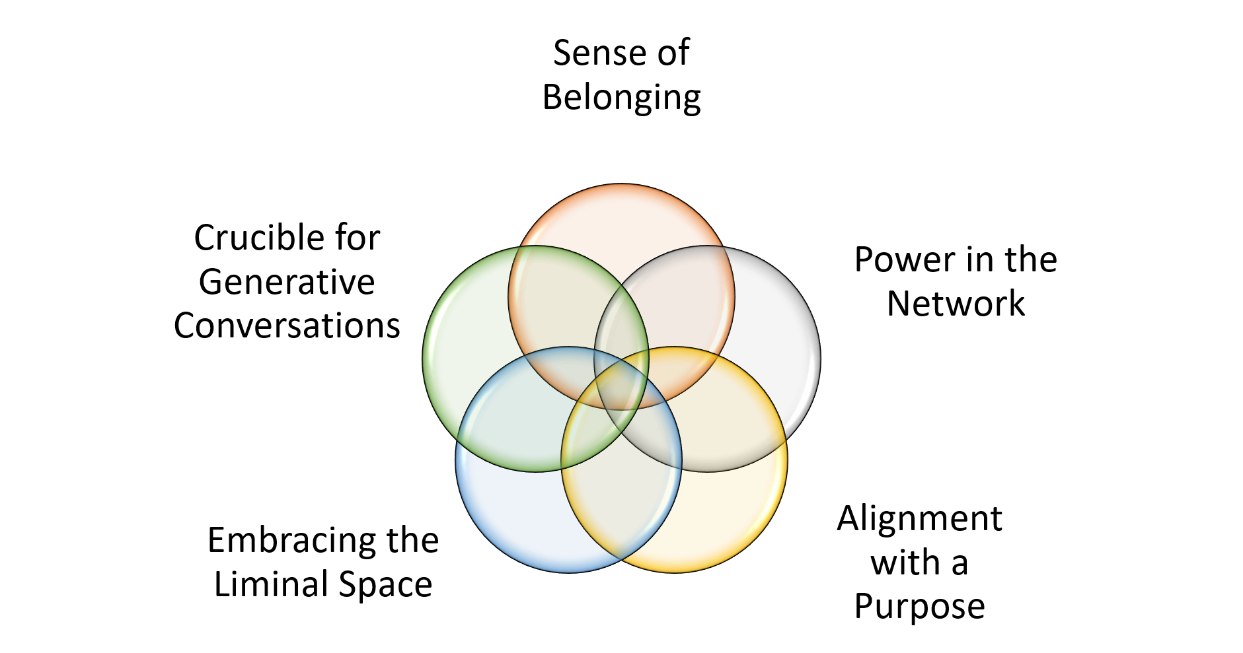
Sense of Belonging. Most often, most people, in most places are desperately trying to fit in — trying to be who they think they should be rather than who they truly are. We hardly ever feel a deep sense of belonging where we can show up in our authenticity and wholeness. There are parts of us we keep hidden knowing that they won’t be accepted. A sense of belonging doesn’t go hand-in-hand with the need to say the “right things”, to succumb to authority, with a loss of autonomy and agency, and a dread of showing up with our warts and all. True belonging comes from the freedom to be exactly who we are — confident and fearless in the knowledge of acceptance.
Communities that can create such safe spaces for everyone to show up authentically in all their uniqueness intact create the conditions for a multiplicity of voices and viewpoints to intertwine, synergize, and integrate. Such communities create the conditions for belonging characterized by invitation, inclusion, inspiration, insight, and interconnection. Only when people fully belong can they participate and contribute from their deepest and integral selves.
Amid this apocalypse, communities can provide us with solace, solidarity, and significance — a sense of being a part of something much larger than we can imagine even as we feel cut adrift from all our familiar moorings. And out of this cohesion, we gain the strength and endurance to hold space for our pain and dare to step into the future that is beckoning us — a future that must necessarily be completely different from our past. Therefore, purposefully formed communities exist at the intersection of individual agency and sovereignty while holding space for collective intelligence and sensemaking.
Power in the Network. A sense of belonging is closely aligned with “power.” We are familiar with “power over,” where some people have positional authority to wield power over others. The “others” are thus rendered powerless, robbing them of agency, sovereignty, and dignity. Dominance, coercion, and control are the keys to exerting power. Right now, most countries are experiencing some form of authoritarian and autocratic government where the latter is exercising power by controlling the resources we need to live — money, food, healthcare, livelihoods, etc., to the detriment and disadvantage of many.
A community has no place for “power over.” Here, the power lies in the spaces between people, in the networks, in the connections. It is shared power that grows out of collaboration and relationships. It is built on respect, mutual support, solidarity, influence, empowerment, and participatory actions. It hinges on the collective ability to act together for the common good. It is “power with” others — the power to collectively make a difference.
When an individual feels a deep sense of belonging and inner alignment with the community’s purpose, this translates into an experience of the “power to” make a difference. “Power to” is an inner sovereignty and agency that is felt as a movement within, an upsurge of one’s unique potential, a generative power emanating from the capacity to birth new possibilities and actions.
Sovereignty is the capacity to take responsibility. It is the ability to be present to the world and to respond to the world — rather than to be overwhelmed or merely reactive. Sovereignty is to be a conscious agent. …
Sovereignty is the center. If you are anchored in sovereignty and able to fully respond to the world, you are able to do the best you can do. ~Jordan Hall
Alignment with a Purpose. Our lives have, for the most part, shrunk to the four walls of our homes. As people shelter in place with lock-down still in effect in many parts of the world, it is easy to get lost in one’s own anxieties and fears. As our world narrows down to our homes, we run the risk of losing our sense of interconnection with the rest of humanity, and the web of life. Now is the time when we most need to come together. Not only as countries but as global citizens connected by a shared experience — perhaps for the first time in our lives.
It is human nature to want to be a part of something larger than oneself. That is the quest we are all a part of. When communities come together around a purpose that speaks to the soul, we know we have found our tribe. This feels empowering, providing meaning and anchor in a collapsing world. The pervasive uncertainty and ambiguity become bearable when we belong to a community, when we support each other in traversing this in-between space, when we are living into the questions that matter.
Embracing the Liminal Space. While as an individual, it can be overwhelming to immerse ourselves in uncertainty and stay in the in-between space, we can do this as a community. In fact, it is only as communities “exploring the intersection of the universal stories of human experience with the personal stories of our lives” can we make sense of what is happening. We can further enhance this by inquiry through multiple modes of reflection so that everyone can fine their own unique way of listening to their inner wisdom.
These can involve solitary practices like guided reflective journaling, creating vision boards, or group practices like sharing stories, music, movement, and any other art form. The idea is to listen to the subliminal voice within us, the inner source of wisdom that we suppress with our superficial cognitive prowess. When we allow this wisdom to rise to the surface, together we weave a “tapestry of truth” with many and diverse threads, creating a pattern that is inclusive, evolutionary, emergent. That includes and transcends the multitude of voices.
Staying in the liminal space asks us to be comfortable with and welcome silence. Silence can be truly generative; by not rushing to fill the silence, we create space for the universe to speak through us. Staying in silence is not a passive act but a conscious one of muting the inane mind-chatter, feeling the stillness within, and tuning into the field of resonance that is created. As we continue to explore, the possibilities latent in the liminal space emerge.
The liminal space is an invitation to surrender — an invitation to give over to something larger than self and trust that we will be held and supported with whatever we need in order to navigate the uncertainty. The degree to which we are comfortable or uncomfortable has to do with how we choose to be with what is happening. We can choose to fight against the liminal space and struggle, or to flow with it by listening, sensing, and responding. ~Alan Seale
Intentional communities help us to stay in this space between stories and navigate it together. That is when — by weaving together the kaleidoscope of narratives and perspectives — we can truly envisage a different world. I believe we are all agents of an interconnected whole, and communities are catalysts propelling us toward a regenerative future.
Crucible for Generative Conversations. This is perhaps the most important function and attribute of an intentional community — to hold space for generative conversations. I have often written about Otto Scharmer’s model of Generative Listening, the foundation of deep and authentic conversations. And I can’t repeat enough the importance of the 4th level of listening (depicted in the diagram below) in holding space for generative conversations:
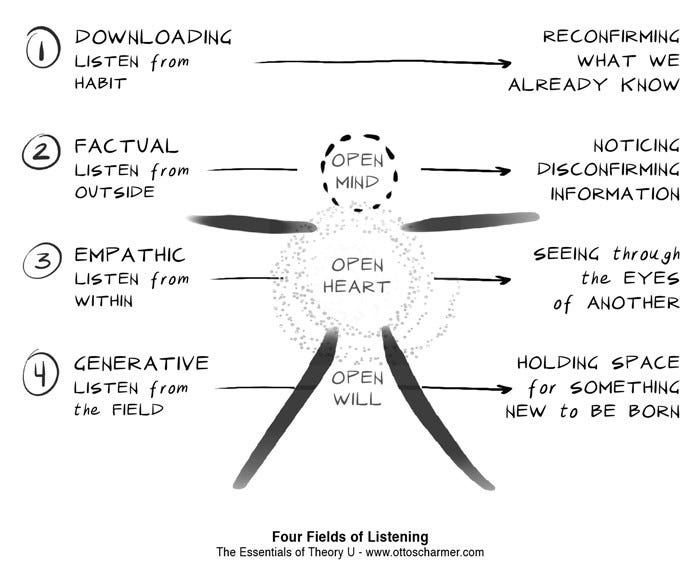
When communities become adept at facilitating “listening from the field,” they can literally listen the new into being. Real dialogue is a flow of meaning and purpose.
The Touchstones from Parker Palmer’s Circle of Trust process are also beautiful guidelines on creating an environment conducive to generative conversations.
o Give and receive welcome.
o Be present as fully as possible.
o What is offered in the circle is by invitation, not demand.
o Speak your truth in ways that respect other people’s truth.
o No fixing, saving, advising, or correcting.
o Learn to respond to others with honest, open questions.
Amid this chaos, how can we collectively hold space and sow the seeds of a different “way of being” on this planet?
Seeds of transformation lie in thoughtful, authentic, and vulnerable conversations. Every life-affirming and regenerative intention and interaction undertaken has far-reaching effect, percolates far beyond our imagination, and ultimately becomes a groundswell displacing the crumbling system.
Read part 1 HERE
Originally published HERE on June 5, 2020
Sahana Chattopadhyay is a global Speaker, Writer, Master Facilitator, Organization Development Consultant, and Coach. She works at the intersection of Complexity, Human Potential, Organizational Transformation, Systems Thinking, and Emergence. Her passion is to enable organizations to develop the capacities, skills, and mindsets to become “thrivable” in the face of uncertainty and ambiguity.
PLEASE DONATE to help Network Weaver continue in it’s mission to offer free support and resources to networks worldwide.
The Power of Communities in Uncertain Times — Part 1
When systems collapse, people rise…
A tiny, invisible, and obscure virus has thrown the world into chaos. It has flummoxed and baffled nations, countries, politicians, scientists, doctors, presidents, principals, parents, students, in short, everyone. The gears of the post-Industrial world have ground to a juddering halt for the first time in history. A great pause button has been pressed. What multiple calamities over the last decade couldn’t achieve has been done by an invisible virus.
Do we see this as Armageddon or a chance to re-imagine a “world that works for all”? Can we appreciate the grand design?
We are witnessing unfathomable and profound suffering, particularly of the marginalized and the deprived, in a world that was horribly unprepared for a global calamity of this nature. Many are likening this period to the 1918 Spanish Flu, which swept across the world killing between 17 million and 100 million people worldwide. We don’t yet know what the death toll of Covid19 will be as the virus rampages across nations made fragile by inequity, flouting all efforts to contain it. What to me seems sad and surprising is the abject failure of high tech, big data, and big pharma in coming up with anything remotely groundbreaking in the face of this apocalypse.
Yet, in the midst of it all, can we hold our fear and uncertainty with compassion? Can we abide in this in-between space and listen to its messages?
Unfortunately, while the situation calls for “collective coherence,” we are experiencing divisive and disruptive politics; segregation of humanity based on religion, race, caste, class, creed, and gender; acrimonious and hostile behavior toward the marginalized and the minorities almost everywhere. These unfolding patterns reveal and underscore the emotional and spiritual schisms, estrangement, and hollowness afflicting societies today. The pandemic, on the other hand, is emphasizing a lesson that is the exact opposite of this sense of separation; it is repeatedly accentuating the deeply intertwined and inter-related nature of all life on this planet.
Are we truly sensing and listening? Do we feel it in our bones that none of us can be happy, healthy, and healed unless all of us are?
Sadly, we have become attuned to the Story of Separation where each one must fend for themselves, defeat the “enemies,” demolish the weak. We are used to waging wars. We can bomb, blast, bulldoze, battle, and build walls to keep the enemy at bay. Unfortunately, the coronavirus does not yield to guns or grenades. Hence, while we seek to “wage a war” against the virus — the language most nations are using — we are failing. Sadly, it also says something about our world that we are more prepared for war than to deal with global health, hunger, and humanitarian crises. No wonder, many governments are trying to handle this like a war. It exonerates them for being singularly unprepared.
The narrative of war is used as a legitimizing discourse. Wars inevitably have casualties. Wars require sacrifice. The narrative of war heroes is used to justify putting health workers at risk.
Not only is the analogy of war misplaced on factual grounds; it also misses the possibility to cultivate an imagination that builds on narratives of peace, solidarity and social justice — and to foster a more acute understanding of how we are all fundamentally dependent on one another as inhabitants of a shared planet.
How would a resilient, responsive, and anti-fragile world have responded to the crisis? What can we collectively do to co-create such a world?
What is becoming evident is that in the face of this apocalypse, it is not high tech and military prowess but high touch and compassion that is saving the day — doctors, nurses, healthcare workers, grocery storekeepers, teachers, journalists, civilians, NGOs. Communities of citizens are coming together to distribute food to the hungry, make masks for hospitals, help stranded migrant workers in India reach home, and much more.
I wonder, when we come out of this crisis, how will our priorities change? How will we honor what truly makes us human? What choices will we make as individuals and collectives to envision and reinvent a resilient and regenerative future?
For a long time, the world has been teetering on the brink of collapse, and now Covid19 has pitched us headfirst into the center of it. The fissures and fractures in our societies and nations, the rifts and ruptures in our politics and policies, and the crudely papered-over sordid and squalid brokenness of the systems stand brutally exposed. We suddenly find ourselves floundering in a liminal space of uncertainty, ambiguity, and unknowing. Lost and adrift emotionally, spiritually, and even physically, we are scrambling to make sense of a world that has fallen apart, whose center proved too weak to hold and sustain. And as the center collapses, we can see the edges rising.
Are we noticing the rise of ordinary citizens? What will it take for this sense of inter-connectedness to persist even after the crisis is past? How can we continue to act from this place of Interbeing?
Despite the superficial gloss and glitz of the 21st century life, we have failed to build resilient societies. We have collectively made choices over decades that have brought us to this point in our civilization’s trajectory. We have ignored signs and warnings of ecological crisis, social turmoil, and political perfidy. We have long forgotten that we are inextricably and indelibly connected to all human and more-than-human life on this planet. I believe that Covid19 is giving us an opening to pause, reflect, and re-imagine a different world — a world of greater equity, justice, well-being, and security for all sentient beings.
What does a more integrated, thrivable, and regenerative world look like? How do we align with our inner source of being? How do we befriend our future emergent selves?
It is asking us to go beyond our current selves, befriend our emergent selves, and co-create a more beautiful world from this liminal space that we are currently in. Perhaps no other writer or poet has captured the essence of it like David Whyte…
Just Beyond Yourself
Just beyond
yourself.It’s where
you need
to be.Half a step
into
self-forgetting
and the rest
restored
by what
you’ll meet.
I see hope arising even in the midst of anxiety and anguish. Our forgotten humanity — submerged in the false busyness of our days — is rising to the surface. I am seeing myriad groups of individuals going beyond their selves and coming together to serve the desperate and the deprived even as governments, strategists, and policy-makers flounder and resort to denial, de-sensing, and destroying every little possibility out of avarice, dishonesty, and egotism. But the “movement of movements” is refusing to be subdued. As Otto Scharmer rightly said, As Systems Collapse, People Rise.
How can we come together as evolutionary communities to heal the planet? How can we bring our gifts in service of a regenerative future?
Paul Hawken described this “movement of movements” beautifully…
I believe that we are part of a movement that is greater, and deeper,
and broader than we ourselves know, or can know.
It flies under the radar of the media, by and large.
It is non-violent. It is grassroots.
It has no cluster bars, no armies and no helicopters.
It has no central ideology.
A male vertebrate is not in charge.
And it is this power of communities that I want to write about. I have been urging organizations to reinvent themselves as communities and ecosystems in my articles, some of which can be found here, here, and here. I believe that the power of communities — people coming together around a shared vision, passion, and purpose — can transform the world and take us toward an anti-fragile, resilient, and regenerative future.
How can communities of diverse and committed individuals reinvent and co-create the metaphors, narratives, and structures for a thrivable future?
“There is no power for change greater than a community discovering what it cares about.” — Margaret J. Wheatley
Let me digress a bit and explain what I mean by “communities.” It is NOT an echo-chamber where homophily — a fancy word for group think — is the norm. Echo-chambers are designed around the concept of “Us” vs “Them” — a constant “othering” that keeps the world polarized, divided, angst-ridden, and adversary-filled. We can see this everywhere with human beings turning against fellow humans on the grounds of caste, class, creed, religion, race, sex, age, food habits, and every other criterion we can imagine. Social media — once the dream of democratic communication and the fount of collective intelligence — have had exactly the opposite effect. It has exacerbated polarization, group-think, and schism under the guise of globally interconnected networks.
Instead of celebrating the vibrant, joyous, and abundant diversity that makes up our world, we are striving to create a monochrome palette that will render our planet dreary, dull, and dangerous. Our very regeneration and resilience lie in diversity and difference. This is where, I believe, consciously designed communities come in. Communities come into being when diverse individuals come together in the service of a purpose larger than themselves. A purpose that feels aligned with their own calling and invites all on a co-creative journey that moves them toward the purpose.
As the old world falls apart, what is emerging are networks of individuals stepping forward to take care of the brokenness, to heal the wounds with whatever resources are available to them, to step beyond the self into a larger space of oneness. They are as diverse as they come and yet they are bound together by a vision of a fairer, just, and a kind and compassionate world. Most of these communities have formed spontaneously in response to the appalling predicaments and miseries being faced by the dispossessed everywhere.
Such communities are built on voluntary participation based on inner alignment and coherence of purpose. They foster a deep sense of belonging, where everyone contributes from their sense of selfhood and unique capabilities. Such synergy cannot be forced but arises from an intermingling of varied perceptions; thus, the whole is always greater than the sum of the parts. Something is born that didn’t exist before. The intangible is expressed, the unthought is revealed, the elusive becomes explicit. The impossible gets done. And a “new way of being” is birthed. Hope refuses to die. New metaphors, narratives, and structures are co-created. Such is the power of intentional communities.
As the world teeters on the brink, we need such compassionate communities to be compasses that can guide us toward a future different from our past, that can become the “imaginal cells” of a more beautiful world our hearts know is possible.
May the best among us, the most visionary, the most inclusive, be the imaginal cells — for now we are in the soup. The outcome of disasters is not foreordained. It’s a conflict, one that takes place while things that were frozen, solid and locked up have become open and fluid — full of both the best and worst possibilities. We are both becalmed and in a state of profound change.
I have explored the qualities and prerequisites of such intentional and conscious communities in Part 2 of this post.
*The tagline of this post is inspired by Otto Scharmer’s article of the same name.
Read part 2 HERE
Originally published HERE on June 1, 2020
Sahana Chattopadhyay is a global Speaker, Writer, Master Facilitator, Organization Development Consultant, and Coach. She works at the intersection of Complexity, Human Potential, Organizational Transformation, Systems Thinking, and Emergence. Her passion is to enable organizations to develop the capacities, skills, and mindsets to become “thrivable” in the face of uncertainty and ambiguity.
PLEASE DONATE to help Network Weaver continue in it’s mission to offer free support and resources to networks worldwide.
How learning ecosystems evolve and how can leaders weave the whole change process
Weaving educational ecosystems in our districts and cities has become one of the greatest worldwide challenges for our systems to enhance learning and equity for the new era. The UNESCO (2020) publication “Education in a Post-COVID World: Nine Ideas for Public Action” indicates that those communities that have responded in an innovative, effective and resilient way to the crisis of COVID-19 are those who had shown greater collaboration between teachers, and between school and community actors. These ideas are also shown by other recent studies on school networks by Daly (2020) Azorín (2020) and Ion & Brown (2020). The reality of this pandemic has reminded us as a species that we are deeply connected to one another (Lancet 2020).
Learning ecosystems are social infrastructure formed by diverse actors that share a purpose, and engage in collaboration to co-design and co-implement innovative responses to existing social and educational challenges. Learning ecosystems provide a new understanding of education from an ecosystemic perspective of actors and their relationships; they challenge traditional organizational boundaries while providing place-based focus on local schools, neighborhoods, cities, or transnational networks; they are based on systemic and cross-sectorial collaboration; and pursue systemic impact (Díaz-Gibson et al., 2020). Thus, one of the most relevant questions in the global educational sphere is how learning ecosystems can be intentionally supported, cultivated and weaved, and how these place based ecosystems grow and evolve over time.
A natural way to approach and better understand learning ecosystems’ development and growth process is to dig into how biological ecosystems change and evolve. Science shows us that collaboration between organisms and species, not struggle for survival that allows ecosystems to evolve and species to truly flourish. As Darwin defended, if humans are the most advanced species it’s because we have the most advanced means of collaborating, and our communities care for the most vulnerable, the sick, the elderly and impoverished. Thus, collaboration is actually a natural and social driver for species survival and for thriving communities.
Ecosystems evolution is drawn byecological succession, understood as the process of change in the species structure of an ecological community over time, where a network of different populations and organisms coexist and interact. The time scale for a biological ecosystem to evolve can be decades -for example, after a wildfire-, or even millions of years. The community begins with relatively few pioneering plants and animals and develops through increasing complexity until it becomes stable or self-perpetuating as a climax community. The engine of succession becomes the impact of established organisms upon their own environments. In other words, intraction among species and within the environment are the drivers of change in all ecosystems.
Colleagues in the NetEduProject have been studying networks, partnerships and ecosystems that enhance learning and equity in the last two decades (Daly, 2010; Riera and Civís, 2008; Díaz-Gibson, 2014; Díaz-Gibson et al, 2017 and 2020). Our learnings show that the development of learning ecosystems and their relational networks become a taugh and complex process that needs time and efforts to be properly cultivated, weaved, and consolidated. Personal relationships require time and intention to emerge and sustain, and their growth involves devoting intentional efforts. With this in mind, Mireia Civís and I have worked on a model to cultivate and weave learning ecosystems in three non linear steps, where we identified some patterns of evolution. Thus, to weave learning ecosystems we need to focus on different conditions depending on its level of maturity:
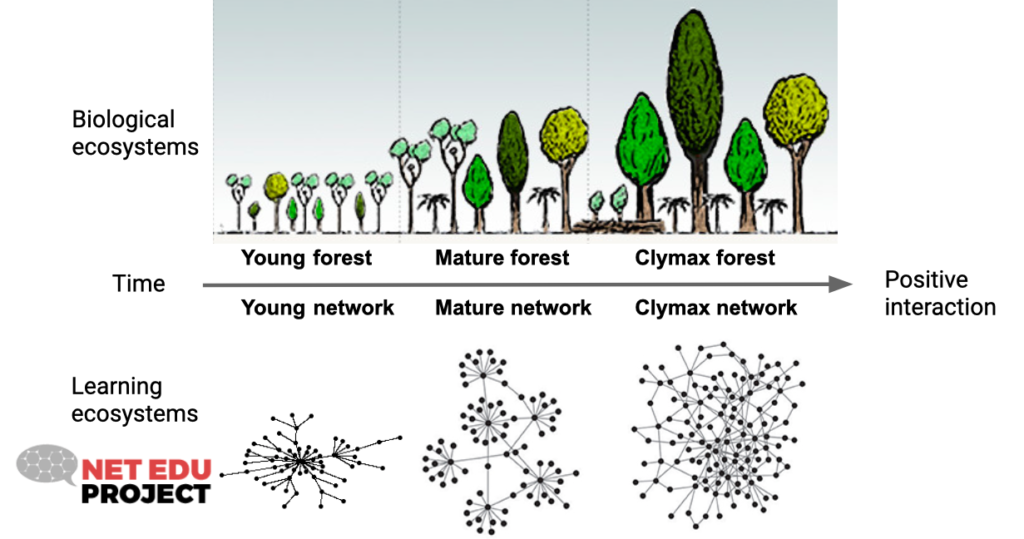
- The initial stage of the ecosystem’s growth is shown in the image as ‘Young network’. Following the idea of ecological succession, ecosystems change depends on the initial conditions found in the social network, and the type and number of actors, and the quantity and quality of relationships draw an initial starting point. At this stage, it is necessary to develop a structural design to cultivate the social foundations that will sustain the whole ecosystem: trust, empathy, recognition of others and collective purpose. It is the moment where members share goals and expectations, adjust rhythms and levels as new relationships are woven. This social capital will sustain the future development of the whole ecosystem of people and organizations, and will become the pillars that pave the way for a new collaborative culture. At this point, collective learning is a priority flow that needs to be planned, at the same time, will be part of the network’s own working culture. Ecosystems can take from one to three years to move into a second stage, and only the construction of solid intangible pillars will allow networks to change and evolve.
- The second stage, named as ‘Mature network’, is more difficult to limit in time as its duration depends on several factors beyond the initial network conditions, such as investment, political support or system coherence. Here, we need to move towards the development and sustainability of social networks, and one of the aims is to consolidate the transition from individual to institutional commitment. It becomes a stage where we want to sustain a collaborative model of action and where we must continue to feed the social intangibles generated. At the same time, new strategies are being sought to assess and increase the impact of collective action. Once networks are weaved, they must come to live and make sense for themselves, they may not depend (or only depend) on external leadership. Also, at this point they must generate clear benefits for their participants according to the established objectives. The design and the structures need to be flexible and readjust to optimize resources to respond to needs and expectations of the people and organizations involved, also drawing clarity on paths for local based outcomes to emerge.
- Finally, the third stage named as ‘Climax network’, is also imprecise in time for the same reasons. In this stage, the ecosystem creates intentional infrastructures for its sustainability beyond personal relationships, establishing institutional agreements, coordination documents, new opportunities for participation, among others. These strategies are aimed to facilitate interaction and self governed initiatives within the network. Here the ecosystem acquires an optimal level of maturity that is evidenced by consolidation of a new culture, where new rules and new ways of doing are practiced in professional and institutional levels. The network organization within the ecosystem in this stage tends to be characterized by a collaborative governance. People are empowered to open new cycles of revision and regeneration in order to create new meaning and new opportunities for individuals and for the collective.
We believe these three fluid and organic steps can inform the type of systemic support needed in the evolution of ecosystems to enhance social capital, learning and equity in our communities and cities across the globe. In the NetEduProject we are ‘hands on’ working on learning and sharing new leadership strategies that can move these social and participatory structures forward over time. As shared in the beginning of this post, science has shown that collaboration is a natural driver for species survival. In this new era we are all embracing, humans and social systems really need to improve our collaborative competences to better take care of one another and create a thriving world for all.
originally published at NET EDU PROJECT
I am a 24-hour learner, passionate collaborator and weaver. Interested in weaving between contexts, disciplines, research and practice to enhance collective impact. I believe that education is a tremendous weapon to change the world.
PLEASE DONATE to help Network Weaver continue in it’s mission to offer free support and resources to networks worldwide.
Collective Mind Workshop Series
Networks and Network Management Skills
Collective Mind is launching a new series of workshops to help you strengthen your network and improve your network practice.
We hear from network practitioners every day that they need support to better understand, analyze, design, and enhance the components of their networks. They seek targeted training to deepen their understanding of how to operate effectively in a network environment. And they want to expand and hone their skills to lead and manage their networks.
Developed using our evidence-based conceptual models for understanding networks and network management, our new workshops are here to help.
Our new workshops
Collective Mind is rolling out six new trainings on the most critical components of networks and network management:
- Shared Purpose
- Membership
- Facilitation
- Coordination
- Network Leadership (in two parts)
New workshops will be launched each month starting in February 2021. The two workshops available each month complement each other and are recommended to be taken in tandem.
February workshops:
Shared Purpose, Membership
Shared Purpose and Membership are the two core network capacities of the seven capacities identified in Collective Mind’s network diagnostic framework. Shared Purpose is the visionary goal around which strategies are defined, people are mobilized, and activities are established and harmonized. Membership is the people and organizations that belong to the network in order to contribute to the shared purpose. Shared Purpose and Membership are the defining features of any network and link inextricably to one another. Shared Purpose is why members show up and contribute to the network. Who members are and how they’re engaged sets the bounds of how the Shared Purpose can be achieved and how it is continually refreshed. Getting Shared Purpose and Membership right is both fundamental for any network and constantly evolving in practice. These workshops will help you clarify and enhance how your network approaches these foundational components of all networks.
March workshops:
Facilitation, Coordination
Facilitation and Coordination are the two fundamental approaches required for effective network management. Collective Mind defines network management as facilitation, coordination, and administration. Facilitation is the act of engaging participants in a process to understand their objectives, plan how to achieve those objectives, and work together to do so. Coordination is the act of helping all those involved in a plan or activity work together in an organized fashion, harmonizing and aligning actions to synchronize efforts towards a common goal. How network managers and practitioners approach their work and the skills they employ directly influences their networks’ effectiveness and impact. Managing within the complexity that networks embody and the emergence that they foster requires facilitating members through processes such as ideation, goal-setting, and consensus building and coordinating them to design and implement joint tasks and activities. These workshops will help you expand your approaches and hone your skills for managing your network.
April workshops:
Network Leadership, Parts 1 and 2
Network Leadership, another network capacity, necessitates both clear roles and responsibilities (part 1) and appropriate skills and approaches (part 2) to lead effectively in a network environment. Leadership is the function of guiding, directing, and facilitating the network and its members. Effective network leadership requires understanding the leadership roles and functions of different stakeholders within the network, from staff to the governing body to members, and clarity in both principle and practice about how those stakeholders will take on those roles both formally and informally. Similarly, network leadership requires non-traditional approaches in an operating environment wherein traditional hierarchical and directive approaches aren’t appropriate and often against network effectiveness. Network leaders in all roles must ensure a network mindset, manage conflict, and foster accountability, among other skills. These workshops will articulate appropriate approaches for network leadership both structurally and in practice and deepen your skills as a network leader.
What will you achieve?
Our workshops will share evidence-based approaches to each topic grounded in extensive research and practice. Participants will clarify content in conversation with our expert moderators and discuss their own challenges and experiences in breakout sessions with network practitioner peers. A worksheet and additional reference materials will enable further reflection and application after the workshop.
Each interactive workshop will:
- Provide you with a framework and approach for thinking about the topic in order to improve your network and strengthen your network practice
- Create a space for learning, reflecting, and applying new ideas moderated by Collective Mind’s team of experts
- Introduce you to new peers amongst other practitioners in the network management space
- Deepen your understanding both through the workshop itself and the additional materials -- readings and reference materials as well as a worksheet -- that will be provided
Interested in joining with your colleagues or team? We can also organize a private session just for you. Contact Kerstin at kerstin@collectivemindglobal.org for more information.
Who should sign up?
Our workshops are designed for those working with and for networks who want to deepen their understanding of networks and bring new approaches to bear to improve their practice and increase the effectiveness and impact of their network. This can include colleagues working in formal network roles, such as staff or members of a governing body, network members, or those who support networks such as funders.
No prior knowledge or training is required for the workshops. In advance of the Shared Purpose, Membership, and Leadership workshops, we suggest that participants join our regular Networks 101 and/or review our blog on network capacities. In advance of the Facilitation and Coordination workshops, we suggest that participants join our regular Network Management 101 and/or review our blog on network management.
How much does it cost?
Each workshop is $100 US per person or bundle workshops for a discounted rate:
- Shared Purpose + Membership = $150 US per person
- Facilitation + Coordination = $150 US per person
- Networks Leadership 1 + 2 = $150 US per person
When can I join?
We’re offering the workshops at multiple times to accommodate global time zones. Double-check the time zones to make sure you sign up for the best times for you!
See all dates and times for scheduled Shared Purpose and Membership workshops here.
Schedules for the Facilitation, Coordination, and Network Leadership workshops will be released soon! Sign up for our newsletter for updates and announcements.
From Rugged Individualism to Self-Organized Connected Communities
In American culture, we tend to prize individual leadership, as illustrated by these examples: the self-made man, the hopes we put in one candidate to solve our problems, the entrepreneur with a new technology or solution, and the non-profit that comes into a community with an innovative project. In reality, any person who comes up with a new idea or initiative brings it into an existing community and/or system with many people, organizations, relationships, ideas, and dynamics already at play.
As someone who makes a living within what some call “the non-profit industrial complex,” I recognize how often the existing work and lived experience of people on the ground who know the situation best can be overlooked as the next wave of visions, strategies, and action plans gets rolled out in a community or system…with the best of intentions. I have worked with communities who have seen many initiatives and projects come and go, often led by the agenda of those with the grants rather than the desires and participation of those most affected.
The rise of participatory collaborative approaches and focus on equity is about switching from a focus on projects and individual leaders to a focus on building the capacity of a community and/or system to self-organize and strengthen the relationships among all those working for change. Instead of the “help from the outside” approach, (e.g., charitable and philanthropic projects,) investment goes to fund local capacity and initiatives that are suited to that particular environment, context, and culture. I’ve recently been inspired by the work of Catalyst for Peace, a foundation that funds grassroots peacebuilding work in Africa. Instead of the common philanthropy or development “outside in” approach, they focus on an “inside out” approach, as this quote from their web site highlights:
In this ‘outside-in’ approach, problem-solving resources and capacities are brought in or worse imposed from the outside and the locus of leadership stays at the national or even international level…. At Catalyst for Peace, we see local people and communities not as problems or as victims—but as leaders, peacebuilders, healers, and agents of change. We use our talents and resources to create space for local leaders and solutions to emerge. That means working in-depth, responsively, and over long periods of time, so that programming springs from locally defined needs and desires.
Sally Goerner and her co-authors in The New Science of Sustainability define “sustainable development” as a system of organized human effort that can maintain its own health and that of the environment forever (or thereabouts.) In the context of development and addressing poverty, the first goal of development is: “to create empowered individuals and groups linked in synergistic, learning relationships.”

They highlight Wangari Maathai, founder of the Green Belt Movement in Kenya and winner of the 2004 Nobel Peace Prize, who organized local women into “virtual circles of empowerment” to plant trees as a way of addressing deforestation and its affects on family life. Goerner et al. highlight why Maathai’s approach is a powerful way to build a local community’s well being for the long term:
“It organizes people and gives them the know-how and mutual support they need to take care of themselves, their families and communities in simple, sustainable ways. It creates networks of local empowerment by organizing local energy and harnessing local intelligence. It also embodies the distributed intelligence and local intricacy principles seen in the human body. Thus, decisions are made, not at 10,000 feet, but at the most immediate level possible and distributed across a community of committed, collaborative, connected citizens.”
Collaborative networks and cross-sector initiatives are focused on creating a fertile environment of connected citizens and organizations, such food policy councils that support more resilient food systems and accountable health coalitions focused on community-wide health. Again, this is about switching the frame from the project to the environment and context that supports many people’s work.
Tom Atlee of the Co-Intelligence Institute and Peggy Holman who studied the patterns of evolution and in particular, how human social systems evolve, helped me to appreciate this shift. Looking at evolution from single celled organism over billions of years to all the many species that exist today, they note that “whatever emerges becomes part of the environment for everything else. The myth of the rugged individual is visibly—perhaps even viscerally—a fallacy from this perspective. There is nothing that exists outside the influence of what already is. For any system to form and persist, it requires its own particular nurturing environment. For any system to develop or shift, it requires its own particular challenging environment.”
Atlee and Holman point out in their paper Evolutionary Dynamics and Social Systems: “Evolution turns out to be a dance between survival of the fittest and the nuanced and less acknowledged embrace—and co-creation—of nurturing contexts.”
The development of collaborative networks along with the collective capacity of communities and those working on similar work to self-organize and collaborate is an investment in the nurturing context to support survival and evolution.
Beth Tener, Principal of New Directions Collaborative, is a facilitator and strategy coach who works with collaborative initiatives that bring together business, government, and the social sector to address complex challenges, such as transitioning to a clean energy economy and revitalizing communities. She helps organizations working on similar issues find their shared purpose, align their work, and create networks for collaboration so they can achieve greater impact. Her work weaves together strategic planning, facilitation with high levels of interaction and participation, network thinking, and leadership skills. Her skills in clear communications and graphics help to convey and communicate the clarity and alignment a group has reached .
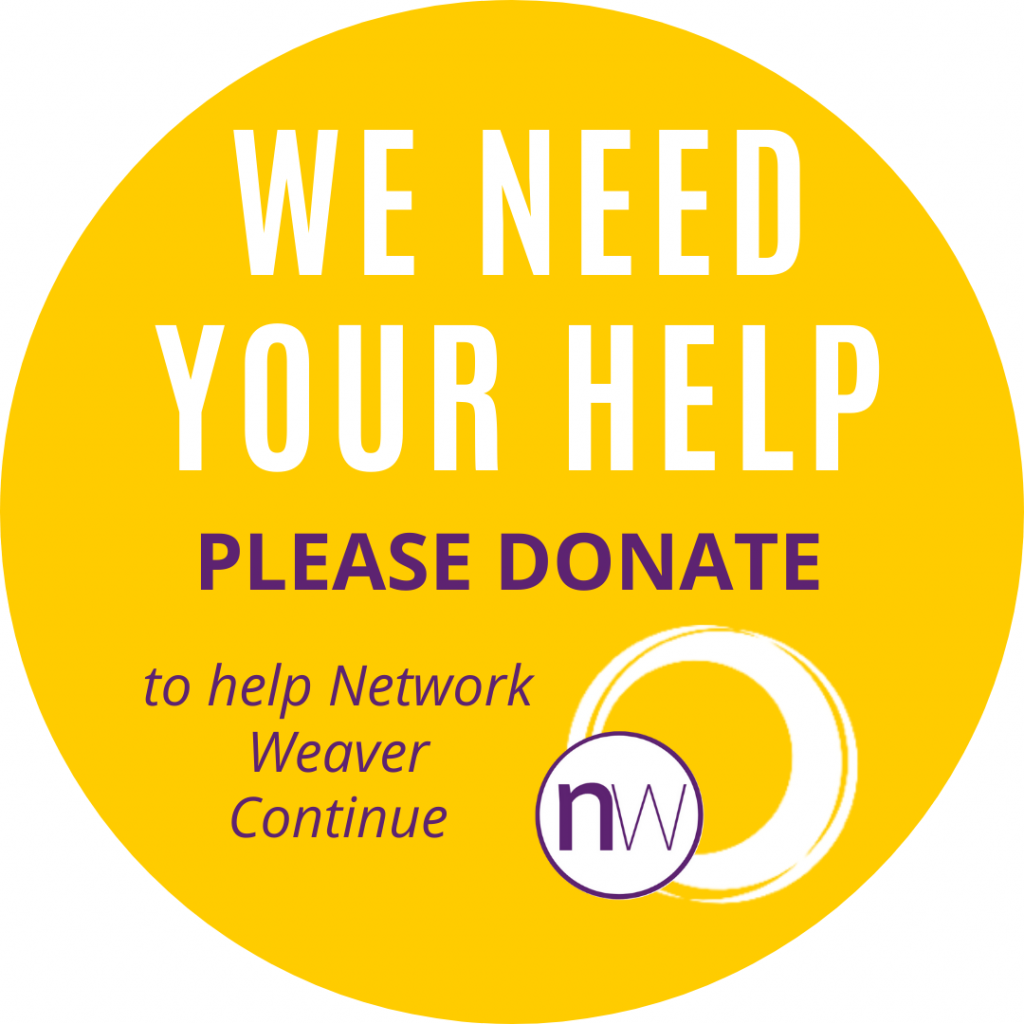
Originally published at New Directions Collaborative
Featured Image found at medium.com/lotus-fruit
Collective Mind Community Conversations
The impact of the pandemic on networks: Learning from network managers’ experiences
Collective Mind hosts regular Community Conversations with our global learning community. These sessions create space for network professionals to connect, share experiences, and cultivate solutions to common problems experienced by networks. In November 2020, Collective Mind hosted a special series of our regular Community Conversations to learn from one another’s experiences of managing networks during the Covid pandemic.
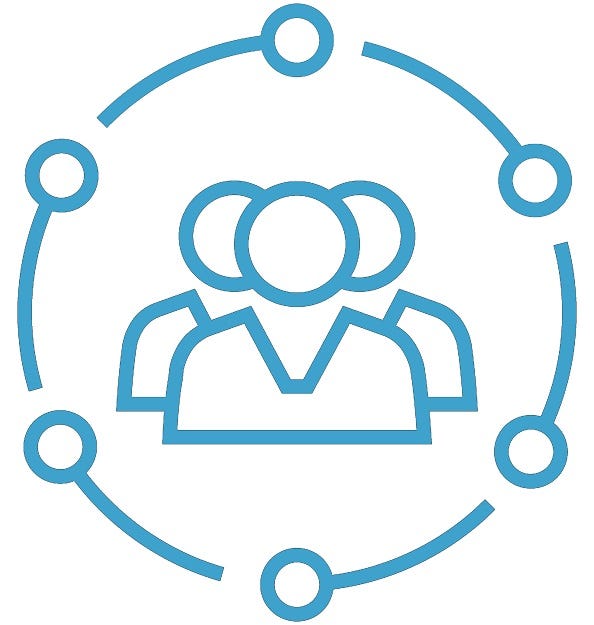
The proverbial wrench that the Covid pandemic has thrown at us all cannot be understated. We’ve had to adapt our lives, work, and workplaces in unanticipated ways while long-term questions continue to linger. For networks and their staff, the impact of the pandemic has raised unique challenges for an already challenging field of practice.
Networks — a catch-all phrase for various types of collective organizing models — function by coordinating members to actively co-create value, community, and impact toward achieving a shared purpose. Behind networks that work in climate change, education, philanthropy, and everything in between, network staff work diligently in service to and in support of their members to accomplish collective goals. In the best of times, network staff wear many hats on behalf of their members: administrator, facilitator, technical expert, cheerleader, counselor, connector, coordinator, wrangler, problem-solver, communications liaison, and more. But in the midst of an enduring global pandemic, new struggles have emerged and old struggles have become amplified.
While many real and threatening struggles persist, the pandemic has also been an opportunity for networks to learn, reflect, and evolve. Eight months in, necessity has led to innovation and the initial experience of shock and uncertainty has transformed into new practices and mindsets. These lessons, insights, and tips from a diverse, global audience of network practitioners give us hope and remind us of the power of networks.
What are networks experiencing in this pandemic, and what can we learn from network managers who have weathered this year?
Building new relationships and partnerships in a pandemic can be challenging — but the pandemic is also an opportunity for more intentional collaborations. The dearth of in-person interactions has made it more difficult to create organic connections, both among network members and with potential outside partners. In-person gatherings offer us chances to meet, engage, and collaborate with colleagues and new contacts in a way that Zoom meetings struggle to recreate. Networks often rely on the spontaneous, serendipitous connections made face-to-face as both a key benefit of being part of the network and as fuel for network engagement. Without in-person spaces, building relationships has felt stilted.
At the same time, moving most of our lives online has opened doors for accessing and discovering new people and creating value together in different ways. Relying on social media and virtual outlets to connect us has become a sort of equalizer, as has the humbling experience of letting the world into our homes through a computer camera. And instead of passive exchanges with many, we’re investing our energy more selectively. As a result, network managers have been forging action-oriented connections with more tangible goals and outcomes. They’re asking important questions such as, what could be mutually beneficial about this relationship? How can we uplift each other, share platforms, and open doors together? What is worthy of everyone’s time? The result is intentional partnerships, anchored in and driven by action and shared value — much like the impetus of a network. Within networks, staff have had to make network weaving more explicit. It can take effort to create virtual collaboration spaces, manage new means of member engagement, or step in to build links and bridge connections. But creating more diverse outlets and on-ramps for connection may also have been overdue (more on this below).
Networks can struggle to stay relevant as members retreat into their own organizations — but there has also been an opportunity to engage members differently and make creative pivots to meet the new operating environment. The upheaval of the pandemic rapidly created unknowns for organizations around funding, staff, programmatic viability, and more that, for many, shifted their focus inward and away from outside commitments. Fostering a network mindset among a membership is already a constant effort but the pandemic created new uncertainties for networks about how to stay relevant to their members, how to fulfill network obligations when participation is unpredictable, and how to maintain engagement without the same ability to bring expected value and benefits to members as before. The pandemic has also affected the missions and activities of some networks, forcing a shift in priorities to meet new demands and address pandemic-related fallout.
In this new landscape, networks understand that they cannot rest on their laurels. Staying relevant and effective requires shaking up norms and embracing new possibilities. Faced with member disengagement, network staff have reimagined opportunities for new kinds of engagement. Listening to members and seeking to understand their needs has been critical for networks to adapt, be responsive, and maintain value. Where possible, staff have gone out of their way to get to know more network members personally and learn directly from them about what an updated value proposition for the network could be. While opening up new avenues for engagement, networks have also embraced the reality of what can get done and how, choosing to postpone or adjust certain network activities.
By centering members in the process of adapting, networks have identified and created paths for leaders to emerge in new ways. They’ve been able to lean into those who have stayed at the table and empower engaged members as network weavers. Leveraging expertise from across the network — like facilitating new groups or sharing skills — has generated new kinds of leadership, and tailoring content for subgroups around their specific interests has helped keep members’ attention. Network staff have had to expand their skillsets and stretch their job descriptions for the sake of stewarding the network. But embracing emergence and relying on members to help shape the network has served to reinforce the origins and intent of a collaborative networks practice.
While we lean on new technology more than ever before, no one tech platform seems to be a silver bullet (yet) — and this may be the lesson we needed all along. For many networks, virtual engagement and collaboration had begun trending long before the pandemic. For others, upgrading technology and transitioning to online platforms was not seen as a priority. Regardless of experience, the pandemic quickly required network staff to become savvy technical administrators and, most importantly, amplified the crises of tech barriers, inequality, and gaps in internet access and stability. Network memberships with older demographics, limited tech experience, and gaps in digital fluency have struggled. Across the board, the impact of relying on tech for participation and the implications for member inclusion and equitability have been significant challenges.
In truth, many of these issues were not new to the pandemic. Social and infrastructure disparities have always persisted (especially between global memberships and Western-led secretariats), and effective technology has been a moving target for years. A meaningful pivot toward embracing tech and finding solutions for inclusion has been a long time coming, and in this way, the pandemic has pushed us forward.
Networks have skilled up and committed to finding solutions to virtual connection, experimenting with a huge range of platforms. They’ve often found that using what people know wins out and that the path of least resistance cannot be underrated. Practitioners emphasize that it’s critical to know and center your audience: some memberships have the skills and bandwidth to use flashy tech platforms, while others will need to use what they know and can access, like Facebook and email. The key is to use what works for your network and build on it, and to accept the inevitability that it may take multiple platforms and channels to address different learning styles and communication preferences. While new platforms can feel annoying or daunting for members, practitioners have found that steadily integrating them as go-to resources, and even giving tutorials or extra guidance, can create new habits and foster successful adoption of new technology. And in the spirit of networks practice, many network managers have also learned to fight the urge to be a gatekeeper to virtual connections or to force uptake of new tools for online collaboration. Staff must often lay the groundwork, but networks flourish by observing and learning from members’ behaviors while allowing for emergence.
The pandemic has tested us — but it has also allowed for personal strengths to evolve and shine. Managing networks effectively involves hard and soft skills, like listening, facilitation, organization, and flexibility. The need to hold space for members during a pandemic has pushed network practitioners to flex these personal attributes, cultivate new skills, and learn about themselves in new ways. Many shared that they have learned to sit with uncertainty — to be resilient and agile, to accept that we might not know what’s going to happen next, and to embrace what comes. Centering practices such as learning, listening, and balance has become essential in work and in life. They’ve also learned to reject rigidity and perfection, and to allow for emergence within the network and in what demands and opportunities come to staff. Ultimately, network managers have been focused on relationships: investing in them, building them, stewarding them, and celebrating them. Relationships anchor networks and relationship management is a core and common skill of network managers. These network management skills are a constant practice, and in these challenging times, practitioners have certainly risen to the occasion.
Collective Mind seeks to build the efficiency, effectiveness, and impact of networks and the people who work for and with them. We believe that the way to solve the world’s most complex problems is through collective action – and that networks, in the ways that they organize people and organizations around a shared purpose, are the fit-for-purpose organizational model to harness resources, views, strengths, and assets to achieve that shared purpose.

Originally published on Medium / Collective Mind
June Holley's Network Weaving Institute

June Holley has created a new entity, the Network Weaving Institute, so that you can easily track and collaborate in her writing and set up time for consultations with her.
June has been weaving networks, helping others weave networks and writing about networks for over 40 years. She is currently increasing her capacity to capture learning and innovations from the field and sharing what she discovers through blog posts, occasional virtual sessions and a forthcoming book. Topics she will be focusing on in the coming year include:
- a communications system where weavers can support each other and share information
- a place to share what people are learning from their practice,
- a set of resources drawn from emergent practice,
- a set of practices to address inequities and
- a social media strategy to draw more people around the globe into the network weaving network.
Her Practice
In 1981 June discovered complexity science and became intrigued with the process of transformation. How could communities change in ways that would make them good places for everyone?
For the next two decades, she worked with others in Appalachian Ohio to catalyze cascades of network experimentation, observing and documenting the dynamics that enabled many hundreds of people to start and then expand businesses in rural Appalachia. With these newly minted entrepreneurs, she mobilized dozens of area organizations to collaborate, self-organize and create an environment that would help these businesses innovate, expand and work together to create an effective support system for networked entrepreneurs.
After twenty years as executive director of the Appalachian Center for Economic Networks (ACEnet), she stepped down to devote her energies to helping communities around the globe form system shifting, self-organizing networks by training and supporting network weavers and helping new networks form.
The hundred or so network projects she has advised range from local networks to international ones; included networks focused on a specific sector such as food access or health access as well as cross sector initiatives such network leadership networks; reached from small rural networks with a few dozen participants to massive networks with thousands of international participants including the networkweavers network. All recent projects have had a strong equity focus and a commitment to dismantling racism and hierarchy. June has led hundreds of interactive workshops – many of them virtual – on applying a network approach and authored the Network Weaver Handbook and over 20 blog posts.
Current and Future Directions: Network Weaving Institute
In the four decades that June has been supporting networks, they have shifted from being a fringe phenomenon to being the favored way of responding to our complex world. But networks come in all shapes and sizes and we still have only rough guidance in knowing which kinds of networks are best for different situations and how they can be most effectively structured.
During the coming decade, June is stepping back from major consulting projects to focus on taking all that she and others have learned about networks with transformative capacity and writing a series of articles (which may well morph into a book or set of videos). This will be done collaboratively as much as possible – sharing her writings in google docs open to commenting and/or joint editing.
June will also continue to develop materials and modules that can be used by individuals or networks to deepen their understanding of networks.
In addition to writing June will identify a few high leverage cross network efforts (connecting more environmental networks to networks promoting equity and the need to dismantle racism and hierarchy, for example, or helping national networks provide more support to local self-organizing efforts) and will provide opportunities to explore network potentials at no cost. If you know of two or more networks that could benefit by being connected, please let June know!
Finally, June will occasionally offer 60 minute one time advice and exploration sessions to networks who have a specific challenge they would like to discuss. Visit the Consultation page to set up an appointment
Click HERE to Visit Network Weaving Institute

A New Year - A Happy Beginning
Happy New Year! The Leadership Learning Community is very happy to kick off the new year by becoming home to NetworkWeaver. This exciting new collaboration is an example of a relationship based on human connection, values alignment and trust.
We anticipate that this new relationship will help us collectively deepen our work; increasing support for BIPOC people in the network space, further exploring the intersections of networks and leadership and strengthening our connections to social justice and transformative change work.
2020 was a tumultuous year, its challenges and opportunities such as the COVID 19 pandemic, racial justice uprisings, and threats to democracy, continue in 2021.
This year, we hope to apply the learnings from 2020 about the importance and power of networks by increasing our investment in and commitment to working in equity-centered, collaborative and networked ways, and we look forward to partnering with you in the process.
Wishing you and yours a wonderful New Year,
The Leadership Learning Community & NetworkWeaver Team
ABOUT THE AUTHOR
Ericka Stallings is the Co-Executive Director of the Leadership Learning Community (LLC) a learning network of people who run, fund and study leadership development.

